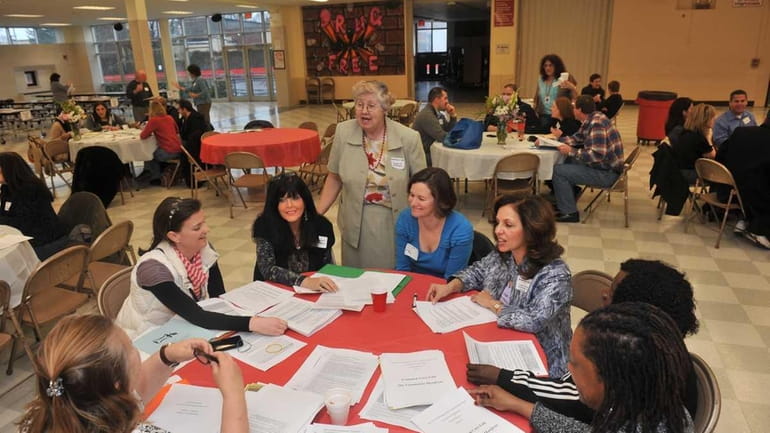Letters: Reconsider the Common Core

March 3, 2012--Teachers from about 20 LI districts meet at Freeport High School to swap "common core" lesson plans. This is part of a national drive by states, including New York, to upgrade curriculums in English and math and make them more uniform. Here Linda Hendrickson of Freeport High School (seen staind and wearing beige, red pearl necklace) leads a discussion with teachers from Nassau, Suffolk, and Queens counties. (Photo by Kevin P. Coughlin) Credit: Kevin P Coughlin/Kevin P. Coughlin
We are veteran high school teachers from Long Island with 35 years of combined teaching experience. We share an entirely different view of the Common Core standards than was portrayed in the article "New ways to teach" [News, April 2].
Over the past year, New York teachers have been introduced to the Common Core standards, which were adopted as part of the competition for "Race to the Top" funding from the federal government. The New York State Education Department claims that these standards will help to accomplish many goals: boost academic literacy and increase college and career preparedness; shift the focus of curricula away from their "mile-wide and an inch deep" formats; and help American students to compete against their global counterparts. While these goals are desirable, we believe that the untested Common Core standards fail to address the true needs of students.
Adopting the standards also further entrenches the trend of "teaching to the test," at the expense of broader educational goals. One needs only to look to the devaluing of social studies and science curricula at the elementary level. On the secondary level, will the Common Core emphasis on English and math similarly devalue the content knowledge in other curricula?
In math, with the new standards, teachers and students will be confronted with a fourth curricular revision in just 15 years. How can we expect results if the expectations are changed so often? Language arts teachers, many with backgrounds in literature and grammar, wonder what form of training they will receive to teach reading, a skill unto itself. A shift in teaching history toward the use of primary-source documents may improve reading skills and build vocabulary, but could come at the expense of content knowledge (as the standards specify, "how Madison defines faction in Federalist No. 10," not what role faction plays in a democracy).
Many teachers question attempting to teach material in the name of college- and career-preparedness to 14- through 17-year-olds who developmentally may not be able to understand and process such material. To what extent will the need to evaluate whether our lessons abide by the standards detract from our efforts to creatively engage our students and make the content relevant to them?
Our school boasts a graduation rate of 76 percent with Advanced Regents diplomas; 96 percent of our students go on to attend a two- or four-year college. Are these achievements no longer valid? We do not understand why education officials want to "fix what ain't broke."
Another concern is the timing. School districts have little money to devote to developing new curricula, providing training to teachers to meet the new requirements, and purchasing textbooks and other materials.
During our careers, New York State has always taken a leadership role in education. Reforms such as Regents exams, grade-level testing, test revision to include higher-order skills (i.e., document-based questions, or DBQs), and secure testing and reporting procedures all attest to that fact. We believe that the State Education Department is undermining the progress it has made in the past 15 years by adopting standards formulated for states that have yet to measure up to ours.
Henry Dircks and Rob Walsh, Bellmore
Editor's note: The writers are teachers in the social studies and mathematics departments at W.C. Mepham High School.
The Common Core methods could show a greater boon to education if they were integrated with programmed instruction. Good programmed instruction methods present material in measured amounts, followed by a comprehension test, cycled with re-presentation until a unit is mastered. Teaching to mastery is a proven, scientific method that leads to high grades.
More teacher time could be spent on one-on-one and small group discussion. This offers good benefits to both students and staff.
Frank J. Mandriota, Bayport
Editor's note: The writer taught biopsychology and experimental psychology at Hunter College.
